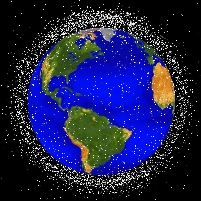The Ever-Growing Problem of Space Junk
Thursday, May 13, 2010
 Low Earth Orbit View of Space Junk (graphic: NASA)
Low Earth Orbit View of Space Junk (graphic: NASA)
So much debris has collected in orbit around the earth that British scientists are now predicting collisions involving operational satellites could occur every five years in the coming decades.
The growing problem became glaringly apparent last year in February when two satellites collided for the first time. One was an active U.S. communications satellite and the other an inoperable Russian satellite. The two smashed into each other northern Siberia while going more than 25,000 m.p.h. The smash-up produced 1,400 catalogued pieces of new space debris, adding to the thousands more already floating around the planet.
In January 2007, China produced 150,000 pieces of debris, including 2,700 that were trackable, when it tested a ballistic missile by destroying a weather satellite. In February 2008, the U.S. used a ballistic missile to destroy a spy satellite, but less debris was created because the strike happened closer to Earth, and most of the debris was burned up in the atmosphere.
Currently orbiting junk ranges from large objects, like old satellites and spent rockets, to tiny pieces, such as paint chips, that also can cause serious damage to functioning spacecraft because of their high orbital speeds.
According to the Parliamentary Office of Science and Technology in the United Kingdom, there are more than 900 active satellites operating around the Earth today. These vulnerable pieces of equipment are used for communications, military purposes and to pursue scientific inquiry.
-Noel Brinkerhoff, David Wallechinsky
Space Debris (POSTnote) (pdf)
The Growing Problem of Space Junk (by Noel Brinkerhoff, AllGov)
- Top Stories
- Unusual News
- Where is the Money Going?
- Controversies
- U.S. and the World
- Appointments and Resignations
- Latest News
- Trump to Stop Deportations If…
- Trump Denounces World Series
- What If China Invaded the United States?
- Donald Trump Has a Mental Health Problem and It Has a Name
- Trump Goes on Renaming Frenzy






Comments